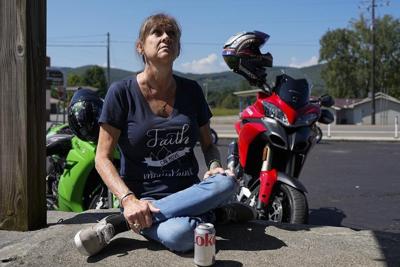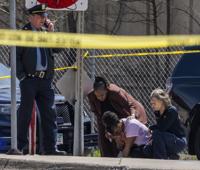A mother whose son was having a seizure in his Tennessee apartment said in a federal lawsuit that police and paramedics subjected the 23-year-old to “inhumane acts of violence” instead of treating him, then covered up their use of deadly force.
The death of Austin Hunter Turner was that an investigation led by The Associated Press identified as happening after police officers used physical force or weapons that were supposed to stop, but not kill, people.
The lawsuit, filed this week in federal court, came after AP reporters shared with Turner's parents, who didn’t know it existed. That footage made the family doubt the official conclusion that a drug overdose killed their son.
Citing the AP's reporting and many of the details it disclosed, the lawsuit focused on how officers' own video contradicted the police version of what happened inside Turner’s small apartment in the northeastern Tennessee city of Bristol.
The officers had said they physically restrained Turner and shocked him with a Taser because he was fighting paramedics who were trying to help him.
The lawsuit said that Turner was “treated as a suspect and not a patient facing a medical emergency" from the moment officers arrived. "Turner was not resisting arrest or being combative. He was not disobeying commands; he was having a seizure.”
Multiple messages left for Bristol Police Chief Matt Austin, Fire Chief Michael Carrier and Mayor Vince Turner were not returned Thursday and Friday. The lawsuit accuses the city and several police officers and firefighters of violating Turner’s civil rights.
For Turner's mother, Karen Goodwin, the lawsuit is a last chance at justice for a son everyone knew as Hunter. Since that night in August 2017, she and her husband, Brian, believed police and blamed their son for his own death. Now she wants those who were there to be held accountable. They should have recognized that her son was having a medical emergency, she said, and she’s angry because she believes they lied.
“We’ve always trusted the police,” Goodwin said. “We didn’t question authority, so when they told us he died of a drug overdose, we believed them.”
The case highlighted : A lack of accountability permeates the justice system in the aftermath of fatal police encounters that don't involve shootings. From the patrol officers at the scene and their commanders to prosecutors and medical examiners, the system shields officers from scrutiny. Some other deaths the investigation documented reflect another reality of policing in America: The fraying of the nation’s social safety net can thrust officers into who need mental or substance addiction treatment.
In Tennessee, it was hard to find an attorney. Goodwin said she contacted 20 before a Nashville law firm agreed to take her case. Lawyers know they have high hurdles even to get a case to trial, including “qualified immunity,” which protects officers from lawsuits.
And this case was even more complicated. Lawsuits seeking monetary damages have statutes of limitations, which in cases like Turner's are one year in Tennessee, according to Dominick Smith, one of the attorneys representing the mother. Though Turner died nearly seven years ago, Goodwin's attorneys believe the case involved a cover-up. They argue that means the clock shouldn’t start until AP reporters shared the police video with the family in August 2023, as part of their investigation with FRONTLINE (PBS) and the Howard Centers for Investigative Journalism at the University of Maryland and Arizona State University.
A judge will decide whether the lawsuit can proceed, said Christopher Slobogin, director of Vanderbilt University Law School's Criminal Justice Program.
If family members can show that a reasonable person could not have known how an injury or death happened at the time, he said, a judge could start the clock when they learned the full picture just under a year ago. The defendants will likely argue that because the family has known about the death since 2017, the statute of limitations has expired.
“You look at what’s fair under the circumstances,” said Slobogin, an expert on Tennessee law who is not involved in the case.
The medical emergency began when Turner suddenly collapsed in his apartment. His girlfriend called Goodwin and said she didn’t know whether he was breathing. Goodwin said to call 911, then rushed over.
When she arrived, Goodwin found her son gasping for breath on the linoleum of his kitchen floor. She told paramedics he had a history of seizures.
Not long after, police officers and firefighters swarmed the apartment. They thought Turner was resisting, but Goodwin said that wasn’t the case — his body was jerking from the seizure.
The bodies of officers and firefighters mostly blocked the mother's view, but she could hear them yelling at her son to stop resisting. An officer shocked him with a Taser.
The group pinned Turner face down on a recliner in what’s known as prone position, which can dangerously restrict breathing. A few minutes later, he was strapped to a stretcher, again face down. He stopped breathing before they got him to the Bristol Regional Medical Center.
In his autopsy report, the medical examiner said Turner died of “Multiple Drug Toxicity” and cited Suboxone, a drug used to wean people off opioids, and the psychoactive chemical in marijuana. The medical examiner also repeated the official police version of events. AP’s investigation found that the medical officials who determine the official cause of police restraint deaths frequently did not link them to force, instead blaming accidents, drug use or preexisting health problems.
Three experts who reviewed case records for the AP said Turner did not die of a drug overdose. Instead, they said the Bristol police made critical errors that contributed to Turner’s death, including pinning him face down.
Goodwin said that, from the start, something didn't seem right about that night. Despite her doubts, for years Goodwin believed first responders did everything they could to save her son. That changed after she watched the video.
Goodwin was stunned. It struck her that officers appeared to ignore they had been dispatched to a medical call. By the end, instead of rushing Turner away in an ambulance, police and paramedics spent six minutes recounting the violence.
___
This story is part of an ongoing investigation led by The Associated Press in collaboration with the Howard Center for Investigative Journalism programs and FRONTLINE (PBS). The investigation includes the Lethal Restraint , and which premiered April 30 on PBS. ___
The Associated Press receives support from the Public Welfare Foundation for reporting focused on criminal justice. This story also was supported by Columbia University’s Ira A. Lipman Center for Journalism and Civil and Human Rights in conjunction with Arnold Ventures. The AP is solely responsible for all content. ___
Contact AP’s global investigative team at Investigative@ap.org or








































